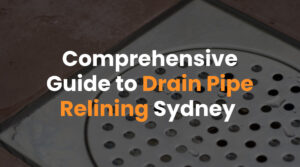Welcome to the comprehensive guide on drain cleaning tools, where we aim to equip homeowners with essential knowledge and skills to manage common drain issues. This guide will walk you through the different types of drains, common causes of blockages and introduce you to an array of drain-cleaning tools.
Understanding Your Drainage System
A home’s drainage system is often a network of pipes that carries waste water away from your home. This system can be broadly divided into two parts: the drainage pipe system within your house (that connects your sinks, showers, toilets etc.), and the sewer system that takes the waste water away from your home to the public sewer or a septic tank. Understanding your drainage system can help you diagnose where a blockage might be located and what tool would be most effective to address it.
Types of Drains in Your Home
Drains in your home can be classified based on their location and use. Here are the primary types you’ll find:
- Bathroom drains: These include sink drains, shower drains, and toilet drains. Shower drains frequently get blocked with hair, soap, and shampoo residues. Toilet drains can become clogged due to inappropriate items being flushed down.
- Kitchen drains: Kitchen sink drains are prone to blockages due to food debris, cooking oils and fats, and soap scum.
- Utility drains: These are drains found in laundry rooms and garages. They can become blocked with lint, dirt, or other debris.
- Outdoor drains: These include downspouts and landscape drains, which can get blocked with leaves, dirt, and other outdoor debris.
Common Causes of Drain Blockages
Common causes of drain blockages vary based on the type and location of the drain.
- Hair: This is a major culprit for bathroom drains. Hair can get tangled and form a blockage, often combined with soap scum and other debris.
- Grease and fat: These are the most common blockage sources in kitchen sinks. When washed down the drain, they solidify and stick to the pipe walls, eventually causing a blockage.
- Foreign objects: Anything that doesn’t break down in water can cause a blockage. This includes items like paper towels, wet wipes, children’s toys, and even jewellery that accidentally falls into the drain.
- Mineral build-up: Minerals dissolved in hard water can build up and cause insoluble masses that can easily block your drains.
- Tree roots: Outdoor drains can be invaded by tree roots searching for water. These roots can cause extensive damage and blockage.
Why You Should Clean Your Drains
Regular drain cleaning is essential for the smooth operation of your home’s plumbing system. It helps prevent blockages that can lead to slow-draining sinks, bathtubs, and toilets, or worse, overflowing drains that can cause water damage. Regular cleaning can also mitigate foul odours caused by food debris or other waste accumulating in your drains. By keeping your drains clean, you can extend their lifespan, prevent costly repairs, and maintain a healthy and comfortable living environment.
Introduction to Drain Cleaning Tools
The choice of tool for cleaning your drain is largely dependent on the location and severity of the blockage. Some basic tools that every homeowner should have include a plunger, a plumber’s snake (or hand auger), and a closet auger. For more stubborn clogs, you might need an electric power auger. Other helpful tools and supplies include a bucket, a wrench, and rubber gloves. The type of cleaner you choose, be it a chemical cleaner or an enzyme-based one, will also depend on the nature of the blockage and your personal preference. We will delve deeper into each tool and how to use it in subsequent sections.
How to Use a Drain Snake
A drain snake, also known as a plumber’s snake or hand auger, is a flexible coil of wire that can reach deep into your drains to break up and remove blockages. Here’s how to use it:
- Preparation: Put on a pair of gloves to protect your hands. Position a bucket underneath the drain to catch any debris.
- Insertion: Insert the end of the snake into the drain opening and start turning the handle clockwise. This will advance the coil into the pipe.
- Locate the Blockage: Keep pushing the snake into the drain until you feel resistance. This is likely your blockage.
- Break Up the Blockage: Once you’ve located the blockage, continue to turn the handle clockwise while pushing gently. This should break up the clog.
- Retrieval: After you’ve broken up the blockage, start turning the handle anticlockwise to retract the snake, bringing the debris with it.
- Cleaning: Once you’ve removed the snake, clean it thoroughly to remove any leftover debris.
Remember to run some water down the drain to ensure the clog is completely cleared.
How to Use Drain Cleaner
Drain cleaners can be an effective solution for dissolving and dislodging clogs. Here’s how to use them:
- Read the Instructions: Each product will have specific usage instructions. Always follow these closely.
- Preparation: Put on gloves and safety glasses to protect your skin and eyes from the chemicals. Ensure the area is well-ventilated.
- Application: Pour the suggested amount of drain cleaner into the drain.
- Waiting Period: Leave the cleaner to work for the recommended amount of time.
- Flushing: After the waiting period, flush the drain with hot water to clear any remaining debris or cleaner.
Types of Drain Cleaners
Drain cleaners come in various forms, including gel, liquid, powder, and crystal. They can also be broadly classified into two categories:
- Chemical Drain Cleaners: These cleaners use powerful chemicals to dissolve clogs. They’re effective but can be harmful to the environment and your pipes if used excessively.
- Enzyme-based Drain Cleaners: These use enzymes or bacteria to break down the clog. They’re safer for the environment and your pipes but may be less effective on severe clogs.
Safety Precautions When Using Drain Cleaners
Safety should be a top priority when using chemical drain cleaners. Here are some precautions to keep in mind:
- Use Personal Protective Equipment (PPE): Always wear gloves and safety glasses to prevent chemical burns.
- Ventilation: Ensure the area is well-ventilated to avoid inhaling harmful fumes.
- Avoid Mixing Chemicals: Never mix different types of drain cleaners, as this can cause dangerous chemical reactions.
- Proper Disposal: Always dispose of drain cleaners properly, according to your local waste disposal regulations. Never pour unused drain cleaner down the drain.
- Keep Out of Reach of Children and Pets: Store drain cleaners in a secure place, out of reach of children and pets.
How to Use a Drain Auger
A drain auger, also known as a plumbing snake, is a more heavy-duty tool designed to tackle stubborn blockages that a plunger or hand snake can’t handle. It operates on the same principle as a hand snake, but its larger size and mechanised operation make it more effective. Here’s how to use it:
- Preparation: Position a bucket underneath the drain to catch any debris and put on protective gloves.
- Insertion: Feed the cable of the drain auger into the drain, continuing until you feel resistance which is the clog.
- Engaging the Clog: Once the clog is located, turn on the auger or crank the handle if it’s a manual model. This rotates the cable, allowing it to chew through the clog.
- Retrieval: Once you’ve broken through the clog, retract the cable, bringing up any debris with it.
- Final Check: Run water down the drain to make sure it’s completely clear.
How to Clear Roots from Drain Pipes
Tree root intrusion is a serious issue that can cause significant damage to your pipes. If roots have infiltrated your drain pipes, you can try a few methods to remove them:
- Mechanical Removal: A drain auger or hydro-jetter can be used to cut through and clear the roots, but this is a temporary solution as the roots can regrow.
- Chemical Root Killers: Products designed to kill tree roots can be used. These chemicals are poured down the affected drain and left to work, killing off the roots and preventing regrowth. These should be used sparingly and as a last resort due to their environmental impact.
Regular Maintenance Tips
Regular drain maintenance can help prevent blockages and keep your drainage system running smoothly. Here are a few tips:
- Regularly Clean Drains: Use a mixture of hot water and vinegar or a mild drain cleaner to clean your drains regularly.
- Use Drain Strainers: These can catch larger debris and prevent it from going down the drain.
- Be Mindful of What Goes Down the Drain: Avoid flushing items that can cause blockages, such as food scraps, fats, and oils, down the drain.
- Regular Inspections: Regularly inspect your drains and pipes for any signs of issues such as slow drainage or recurring clogs.
When to Call a Professional
While minor clogs can often be handled with a plunger or drain snake, more complex issues require a professional plumber. If you’re facing persistent clogs, significant water backflow, or suspect a tree root intrusion, it’s time to call in the professionals. Additionally, if you are uncomfortable using chemical cleaners or mechanical tools, professional plumbers can provide safe and effective service. They have the experience and tools necessary to diagnose and solve your plumbing problems without risking further damage to your system.
Plumbwell Plumbing Services: The Blocked Drain Experts in Sydney
Dealing with stubborn drain blockages? Don’t let it dampen your day. When it comes to unblocking drains, no one does it better than Plumbwell Plumbing. We have a team of expert plumbers equipped with the latest tools and techniques, ready to help you resolve your drain problems quickly and effectively.
As proud members of the Sydney community, we offer our premium plumbing services across the city. Whether you’re located in the bustling Sydney CBD, the vibrant Inner West, the scenic Eastern Suburbs, the beautiful Northern Beaches, or the peaceful North Shore, we’ve got your plumbing needs covered.
At Plumbwell Plumbing, we understand that a blocked drain can throw your entire day off track. That’s why we’re dedicated to delivering fast, efficient, and hassle-free service to get your life back on course.
Ready to say goodbye to blocked drains? Don’t wait, give Plumbwell Plumbing a call today at (02) 9064 2861, and let Sydney’s blocked drain experts take care of the rest.








